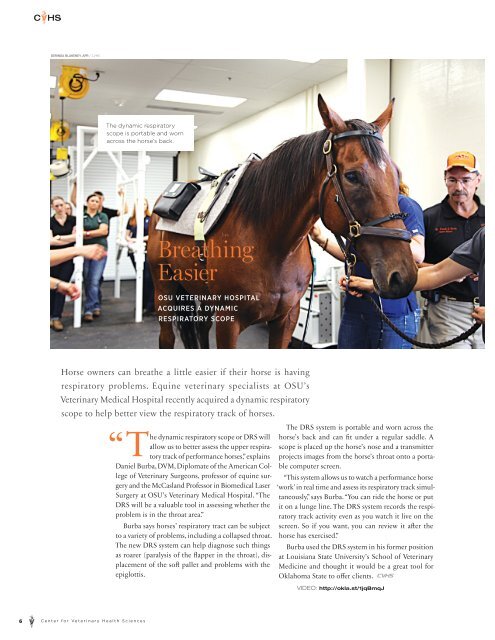Vet Cetera magazine 2015
Official magazine of the Center for Veterinary Health Sciences at Oklahoma State University
Official magazine of the Center for Veterinary Health Sciences at Oklahoma State University
Create successful ePaper yourself
Turn your PDF publications into a flip-book with our unique Google optimized e-Paper software.
DERINDA BLAKENEY, APR / CVHS<br />
The dynamic respiratory<br />
scope is portable and worn<br />
across the horse’s back.<br />
Breathing<br />
Easier<br />
OSU VETERINARY HOSPITAL<br />
ACQUIRES A DYNAMIC<br />
RESPIRATORY SCOPE<br />
Horse owners can breathe a little easier if their horse is having<br />
respiratory problems. Equine veterinary specialists at OSU’s<br />
<strong>Vet</strong>erinary Medical Hospital recently acquired a dynamic respiratory<br />
scope to help better view the respiratory track of horses.<br />
dynamic respiratory scope or DRS will<br />
allow us to better assess the upper respiratory<br />
track of performance horses,” explains “The<br />
Daniel Burba, DVM, Diplomate of the American College<br />
of <strong>Vet</strong>erinary Surgeons, professor of equine surgery<br />
and the McCasland Professor in Biomedical Laser<br />
Surgery at OSU’s <strong>Vet</strong>erinary Medical Hospital. “The<br />
DRS will be a valuable tool in assessing whether the<br />
problem is in the throat area.”<br />
Burba says horses’ respiratory tract can be subject<br />
to a variety of problems, including a collapsed throat.<br />
The new DRS system can help diagnose such things<br />
as roarer (paralysis of the flapper in the throat), displacement<br />
of the soft pallet and problems with the<br />
epiglottis.<br />
The DRS system is portable and worn across the<br />
horse’s back and can fit under a regular saddle. A<br />
scope is placed up the horse’s nose and a transmitter<br />
projects images from the horse’s throat onto a portable<br />
computer screen.<br />
“This system allows us to watch a performance horse<br />
‘work’ in real time and assess its respiratory track simultaneously,”<br />
says Burba. “You can ride the horse or put<br />
it on a lunge line. The DRS system records the respiratory<br />
track activity even as you watch it live on the<br />
screen. So if you want, you can review it after the<br />
horse has exercised.”<br />
Burba used the DRS system in his former position<br />
at Louisiana State University’s School of <strong>Vet</strong>erinary<br />
Medicine and thought it would be a great tool for<br />
Oklahoma State to offer clients.<br />
VIDEO: http://okla.st/1jqBmqJ<br />
6 Center for <strong>Vet</strong>erinary Health Sciences


